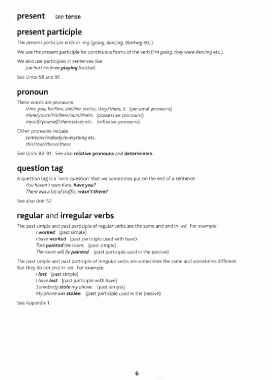Page 397 - murphy_raymond_english_grammar_in_use 1
P. 397
p re se n t see tense
present participle
The present participle ends in -ing (going, dancing, thinking etc.).
We use the present participle for continuous forms of the verb (I'm going, they were dancing etc.).
We also use participles in sentences like:
Joe hurt his knee p la y in g football.
See Units 68 and 97.
pronoun
These words are pronouns:
I/me,you, he/him, she/her, we/us, they/them, it (personal pronouns)
mine/yours/his/hers/ours/theirs (possessive pronouns)
myself/yourself/themselves etc. (reflexive pronouns)
Other pronouns include:
someone/nobody/everything etc.
this/that/these/those
See Units 82-91. See also relative pronouns and determiners.
question tag
A question tag is a ‘mini-question' that we sometimes put on the end of a sentence:
You haven’t seen Kate, h a v e y o u ?
There was a lot of traffic, w a s n ’t th e r e ?
See also Unit 52.
regular and irregular verbs
The past simple and past participle of regular verbs are the same and end in -ed. For example:
I w o rk e d (past simple)
I have w o rk e d (past participle used with have)
Tom p a in te d the room, (past simple)
The room will be p a in te d , (past participle used in the passive)
The past simple and past participle of irregular verbs are sometimes the same and sometimes different.
But they do not end in -ed. For example:
I lo s t (past simple)
I have lo s t (past participle with have)
Somebody s to le my phone, (past simple)
My phone was s to le n , (past participle used in the passive)
See Appendix 1.
6

